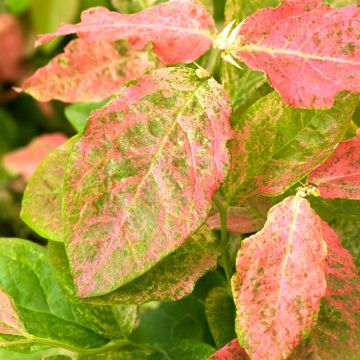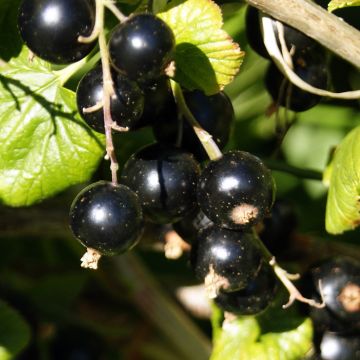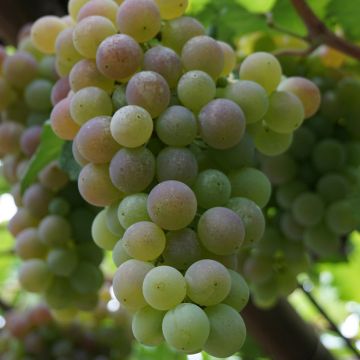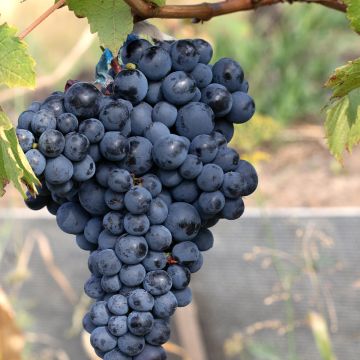

Vaccinium Tophat - myrtillier d'Amérique


Vaccinium Tophat - myrtillier d'Amérique
Vaccinium Tophat - Blueberry
Vaccinium Tophat
Bilberry, Whortleberry, Blueberry, Cranberry
This item cannot be shipped to the selected country
Delivery charge from €5.90
Delivery to Corse prohibited
More information
Schedule delivery date,
and select date in basket
This plant carries a 6 months recovery warranty
More information
We guarantee the quality of our plants for a full growing cycle, and will replace at our expense any plant that fails to recover under normal climatic and planting conditions.
From €5.90 for pickup delivery and €6.90 for home delivery
Express home delivery from €8.90.
Delivery to Corse prohibited: UE law prohibits the import of this plant from mainland France to Corse as part of the fight against Xylella fastidiosa. Please accept our sincere apologies.
More information
Description
Vaccinium 'Tophat' is a hybrid American blueberry bush with a particularly compact habit. This self-fertile variety produces an abundance of small, dark blue, sweet fruits in summer, after a beautiful white bell-shaped flowering in spring. Its small size allows it to be planted along terraces or in vegetable gardens. In autumn, the leaves take on warm red-orange hues. This bush requires moist to wet, well-drained and acidic soil to grow properly, in light sun or partial shade.
The American blueberry bush belongs, just like rhododendrons, heathers and andromedas, to the large Ericaceae family. In the vast majority of cases, these species appreciate a rather moist and especially acidic soil. The presence of limestone in the soil causes them to quickly turn yellow and wither. Vaccinium corymbosum is an irregular and bushy shrub, reaching about 1.50 m (5ft) in height and width. In May, it produces many honey-scented white bell-shaped flowers, followed a few weeks later by abundant clusters of the famous dark blue, slightly powdery blueberries. The fruits are less intensely flavoured than our European blueberries, but much larger, with a diameter of up to 1 cm (0in). They are the ones most often found for sale, as they are grown on a large scale. However, they are rich in nutrients and antioxidants. The leaves are deciduous and lanceolate and take on beautiful vivid colours ranging from scarlet red to yellow, passing through orange in autumn.
The 'Tophat' variety is the result of a cross-breeding between this species and Vaccinium angustifolium (narrow-leaved blueberry), another wild species similar to our European blueberries. 'Top hat' has a very compact habit (about 60 cm (24in) in all directions, maximum). It is also self-fertile: a single plant is capable of bearing fruit - however, it is better to plant several for better pollination. The fruits are relatively small (between 0.5 cm (0in) and 1 cm (0in)) but numerous and very sweet, in June-July. In general, it takes 2 years to achieve optimal yields.
Provide 'Tophat' blueberry bush with moist, even wet but well-drained, acidic soil (devoid of limestone, with a pH below 6). One can use ericaceous compost to correct soil that is too heavy, compact, and clayey, but do not expect to obtain good results in soil that is too far from the required conditions. The shallow roots quickly suffer from prolonged dryness. Full sun should be avoided, especially in hot regions, light shade sheltered from cold and dry winds is better. These bushes are extremely hardy and can withstand at least -20°C (-4°F). To ensure a good harvest, it is best to plant at least two or three plants of the same variety, or different varieties, close to each other. Then, you can prepare excellent pies, jams, jellies, custards...
Vaccinium 'Tophat' will fit well in an edible garden, especially since it is also very pleasant to snack on the fruits directly from the plant during the right season. Its small size also makes it particularly suitable for container cultivation, provided you do not forget to water it. You can place the pot (make sure it is large enough) in a metal basin or a large wooden container, to always keep the bottom wet. Also, remember to use water low in limestone, such as rainwater! Finally, you can grow them with other acid-loving plants: rhododendrons, Pieris, or even camellias...
Report an error about the product description
Vaccinium Tophat - Blueberry in pictures


Plant habit
Fruit
Flowering
Foliage
Botanical data
Vaccinium
Tophat
Ericaceae
Bilberry, Whortleberry, Blueberry, Cranberry
Cultivar or hybrid
Other Blueberry bush
Planting and care
If the soil suits it, the American Blueberry will grow and fruit on its own. Plant it in acidic soil (pH between 4 and 5.5), ericaceous soil or a mixture of regular soil and compost or well-decomposed bark compost. In limestone soil, you need to dig a hole 50 to 60 cm (20 to 24in) deep, line the edges with a garden felt, lay a non-limestone gravel bed 10 cm (4in) thick at the bottom, then fill with an acidic soil mixture. The soil must remain moist but without stagnant humidity. If you need to water, use non-limestone and non-chlorinated water. This bush likes filtered light, especially in a region with hot summers. It should be protected from dry winds and high temperatures. Mulch the base with crushed bark, straw, or fern leaves.
Planting period
Intended location
Care
This item has not been reviewed yet - be the first to leave a review about it.
Berries
Haven't found what you were looking for?
Hardiness is the lowest winter temperature a plant can endure without suffering serious damage or even dying. However, hardiness is affected by location (a sheltered area, such as a patio), protection (winter cover) and soil type (hardiness is improved by well-drained soil).

Photo Sharing Terms & Conditions
In order to encourage gardeners to interact and share their experiences, Promesse de fleurs offers various media enabling content to be uploaded onto its Site - in particular via the ‘Photo sharing’ module.
The User agrees to refrain from:
- Posting any content that is illegal, prejudicial, insulting, racist, inciteful to hatred, revisionist, contrary to public decency, that infringes on privacy or on the privacy rights of third parties, in particular the publicity rights of persons and goods, intellectual property rights, or the right to privacy.
- Submitting content on behalf of a third party;
- Impersonate the identity of a third party and/or publish any personal information about a third party;
In general, the User undertakes to refrain from any unethical behaviour.
All Content (in particular text, comments, files, images, photos, videos, creative works, etc.), which may be subject to property or intellectual property rights, image or other private rights, shall remain the property of the User, subject to the limited rights granted by the terms of the licence granted by Promesse de fleurs as stated below. Users are at liberty to publish or not to publish such Content on the Site, notably via the ‘Photo Sharing’ facility, and accept that this Content shall be made public and freely accessible, notably on the Internet.
Users further acknowledge, undertake to have ,and guarantee that they hold all necessary rights and permissions to publish such material on the Site, in particular with regard to the legislation in force pertaining to any privacy, property, intellectual property, image, or contractual rights, or rights of any other nature. By publishing such Content on the Site, Users acknowledge accepting full liability as publishers of the Content within the meaning of the law, and grant Promesse de fleurs, free of charge, an inclusive, worldwide licence for the said Content for the entire duration of its publication, including all reproduction, representation, up/downloading, displaying, performing, transmission, and storage rights.
Users also grant permission for their name to be linked to the Content and accept that this link may not always be made available.
By engaging in posting material, Users consent to their Content becoming automatically accessible on the Internet, in particular on other sites and/or blogs and/or web pages of the Promesse de fleurs site, including in particular social pages and the Promesse de fleurs catalogue.
Users may secure the removal of entrusted content free of charge by issuing a simple request via our contact form.
The flowering period indicated on our website applies to countries and regions located in USDA zone 8 (France, the United Kingdom, Ireland, the Netherlands, etc.)
It will vary according to where you live:
- In zones 9 to 10 (Italy, Spain, Greece, etc.), flowering will occur about 2 to 4 weeks earlier.
- In zones 6 to 7 (Germany, Poland, Slovenia, and lower mountainous regions), flowering will be delayed by 2 to 3 weeks.
- In zone 5 (Central Europe, Scandinavia), blooming will be delayed by 3 to 5 weeks.
In temperate climates, pruning of spring-flowering shrubs (forsythia, spireas, etc.) should be done just after flowering.
Pruning of summer-flowering shrubs (Indian Lilac, Perovskia, etc.) can be done in winter or spring.
In cold regions as well as with frost-sensitive plants, avoid pruning too early when severe frosts may still occur.
The planting period indicated on our website applies to countries and regions located in USDA zone 8 (France, United Kingdom, Ireland, Netherlands).
It will vary according to where you live:
- In Mediterranean zones (Marseille, Madrid, Milan, etc.), autumn and winter are the best planting periods.
- In continental zones (Strasbourg, Munich, Vienna, etc.), delay planting by 2 to 3 weeks in spring and bring it forward by 2 to 4 weeks in autumn.
- In mountainous regions (the Alps, Pyrenees, Carpathians, etc.), it is best to plant in late spring (May-June) or late summer (August-September).
The harvesting period indicated on our website applies to countries and regions in USDA zone 8 (France, England, Ireland, the Netherlands).
In colder areas (Scandinavia, Poland, Austria...) fruit and vegetable harvests are likely to be delayed by 3-4 weeks.
In warmer areas (Italy, Spain, Greece, etc.), harvesting will probably take place earlier, depending on weather conditions.
The sowing periods indicated on our website apply to countries and regions within USDA Zone 8 (France, UK, Ireland, Netherlands).
In colder areas (Scandinavia, Poland, Austria...), delay any outdoor sowing by 3-4 weeks, or sow under glass.
In warmer climes (Italy, Spain, Greece, etc.), bring outdoor sowing forward by a few weeks.





















































